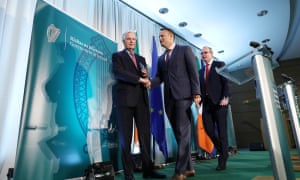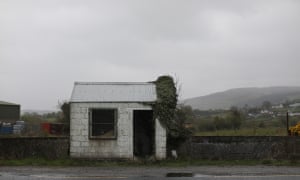Pointing down the hill at an opening in the metal fence that runs through north Belfast’s Alexandra Park, Ciarán Shannon, 58, recalls venturing to the bottom end of the park when he was about 12. “I was chased out by loyalist kids. From then until 2011, I hadn’t set foot in the other side of the park. There are an awful lot of stories like that.”
The three-metre fence, one of scores of so-called “peace walls” that still divide loyalist and nationalist communities in Northern Ireland, was erected in 1994. Yet thanks to work by cross-community workers such as Shannon, and after a lengthy consultation exercise, the gate was added in 2011.
“We were having people coming from all over the world to look at our gate,” he says. “It was the symbolism. People started moving freely through it. Gradually we opened it later and later. Now we’re in the position where it’s open all day, every day.”
Twenty years on from the Good Friday Agreement, similar cross-community projects are under way with the aim of taking down peace walls across the city. The fact that so many remain in place is evidence of the often glacial pace of progress. As the painstaking work continues, however, it is not lost on those labouring to bring down physical and sectarian barriers that the vote for Brexit has led to the threat of new ones being erected.
There has been much talk of the impact that the return of any kind of border would have on the economies north and south of that border in Ireland – an official assessment suggested it would take an 8% hit to economic growth under the British government’s preferred Brexit outcome. Yet, when talking to some of those involved in promoting both cross-border trade and cross-community relations, it is the psychological impact of the renewed uncertainty that is concerning them as much.
The British and Irish governments and the European Union have all said that they do not want the return of any border infrastructure on the island of Ireland. Yet London’s determination to leave both the EU’s customs union and the single market has created a policy problem that is proving perhaps the most challenging aspect of the Brexit fallout.
When Michel Barnier, the EU’s chief Brexit negotiator, visited border communities and businesses last week, he was told in no uncertain terms about the strength of feeling involved in even the most innocuous border equipment.
“I’m 60 years old, I’ve lived right along the border all my life,” says Declan Fearon, a kitchen maker who is part of a border group that met Barnier. He used to be able to see a border watchtower from his house near Jonesborough. “I remember the days when some people who came to mass on a Sunday used to have to park at the barriers and walk to the chapel. The last watchtower to be taken away was the one right behind my home.

“I’ve lived through all of that and I really fear the return of any of that for my grandkids and the psychological impact on a community here that lived with it for so many years. It’s reopening a wound. It is quite clear that no one wants a return to the border, but are the British government being genuine on proposing how to do that? No, they’re not. There was palpable anger felt here when Boris Johnson compared this issue to the London congestion charge. Come along and meet the people who are worried about this.”
One official who has been working on cross-border trade since the Good Friday Agreement recalls that, at the start of the process, he had to attend all meetings with the text of the legislation piled on the table, because there were inevitable arguments about interpreting the level of cooperation it stipulated.
Now the meetings have become reassuringly boring, focused on how to help economies both north and south. “When we started, we were looking at barriers,” the official explains. “Now we look at opportunities. With Brexit, there’s the potential that you could be going back to dealing with barriers, and I think everyone is agreed that that isn’t what we want.”
In Belfast, as with so many issues, many fear that Brexit and the border issue is already adding another sectarian strut to community politics. In Tigers Bay, the loyalist community on one side of Alexandra Park, a new mural appeared during the referendum campaign that reads “Vote Leave EU” and is accompanied by a reference to a biblical verse: Revelation chapter 18 verse 4.
The verse states: “And I heard another voice from the heaven, saying, Come out of her, my people, that ye not be partakers of her sins, and that ye receive not of her plagues.” Rab McCallum, a former republican prisoner who now works to remove peace walls through the North Belfast Interface Network, is among those with concerns. He is sitting in a coffee shop in the Houben Centre, north Belfast, another cross-community project. It has an entrance on either side of the building, in effect connecting the loyalist and nationalist parts of what he describes as “one of the most notorious interfaces in all of the Troubles”.
“There have been more people killed here than all other areas, so it has been hugely impacted by the conflict,” he says. “We had the success of taking down the first peace wall in 30 years, just across the road, at a time when there were problems. Despite the lack of political progress, the people on the ground seemed to be in front of the political process.
“There is that uncertainty [around Brexit], and though it isn’t something people talk about all the time, it does seem to be seen through identity more than economics. It just raises the question, are we going to take a step backwards rather than a step forwards? It has in some ways sectarianised things again. People are worried about it economically, but also politically. It creates an unease.”
The everyday impact of the border dilemma is being missed in the Westminster debate, warns Deirdre Heenan, professor of social policy at Ulster University, who is also from a border community near Newry.
“I was in London last week and there was discussion about the trade and the economy and the customs union and the single market, but absolutely no discussion of the psychological and social impact of a border – whatever it may look like,” she says.
“Most people believe that the British government don’t understand the problem. It’s not only that they haven’t come up with a solution, it’s that they can’t come up with a solution to a problem they don’t understand.
“Clearly in the referendum, the fact that we would be the only land border to the EU wasn’t thought about. We were an afterthought. Yes, we have a peace, but it is a fragile peace. It is a journey we are on and we haven’t reached the final destination.
“Sometimes it sounds like overstatement, but borders have an emotional meaning and they are symbols of difference. That just seems to be dismissed, but it is hugely significant for people here.”
Of the Irish officials and ministers the Observer consulted last week, all said that the British government had failed to provide any confidence that it had a solution to resolve its promise of a frictionless border. As a result, all pointed to the so-called “backstop” agreement signed by Theresa May last year, which dictates that, should the UK government fail to provide a solution, Northern Ireland would remain in a “common regulatory area” with the EU.
“The UK government signed off on a backstop arrangement,” says Michael Creed, the Irish agriculture minister. “That’s the fail-safe. For reasons that transcend economics, there can be no resiling from that commitment. If the UK comes up with a better arrangement, obviously the Barnier taskforce and the Irish government are quite open to seeing the colour of that and how it would effectively operate. There can be no resiling from that backstop arrangement.”

For all the concerns, however, supporters of Brexit warn that the issues around the border and the impact on the peace process are being inflated as a negotiating tactic by both Ireland and the EU. Refusing to give any ground could ultimately force the UK to remain inside the bloc’s customs union and single market.
“The border is perfectly solvable,” says Lee Reynolds, the DUP director of policy and former Vote Leave coordinator in Northern Ireland. “Things that were presented as insurmountable have already been surmounted. The EU is offering a no-tariff deal already. There are a lot of things that were part of Project Fear that have been dealt with and resolved. They were legitimate things to raise, but it doesn’t mean they were impossible.
“The border has got wrapped up in much bigger negotiating politics. It isn’t true that there is no solution. It’s that some people would prefer there not to be one. The best thing that ever happened for Vote Leave was when Tony Blair and John Major came over to threaten the peace process. That’s when unionists drifting to Leave became like snow off a ditch.”
He adds that, far from undoing cross-community work, Brexit could be an opportunity for more. “Brexit is not an event, it’s what we do with it,” he says. “We can rethink regional policy and try to do better things. There will be potential for more resource – we have money coming back to us. People are talking about keeping existing money, when they should be asking if there is any scope for more. A new round of peace funding has also been secured.”
This sunny optimism cuts little ice with people such as Fearon. He believes that feeling on the issue is so strong, and the determination not to return to the bad old days so deep-rooted, that people might take matters into their own hands should any border infrastructure pop up.
“As [the former taoiseach] Bertie Ahern said recently, it wouldn’t take paramilitaries to come back to start a campaign against the reimposition of a border,” he says. “The local people in every area would do it. It is that palpable anger that is out there. They are not closing that road again. I hear that all the time.”
Post-Brexit options for a border problem
The technological solution
Leading Brexiters argue that new technology can be used to find ways of allowing frictionless trade across the Irish border - and the technology would not have to be placed on the border itself. However, details have been thin on the ground and many warn that no such solution currently exists.
A special deal
The European Union would allow Northern Ireland to stay in the customs union and the single market, but that would mean checks between Northern Ireland and mainland Britain - an outcome fiercely opposed by unionists. It would also lead to demands for a similar deal for Scotland, putting Scottish Tory MPs at loggerheads with the leadership.
A customs partnership
The UK would collect tariffs on the EU’s behalf, easing the need for border checks. Problems remain, however. The idea is opposed by Brexiter cabinet ministers and dismissed by the EU. A partnership would also have to be accompanied by a degree of alignment with the EU’s single market to eliminate checks completely.
Soft Brexit
Opting to keep the entire UK fully inside the EU’s customs union and single market would provide a solution to the Irish border, but would also require Theresa May to rip up her red lines of leaving both. It would also mean Britain could not strike its own trade deals.